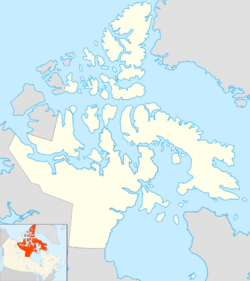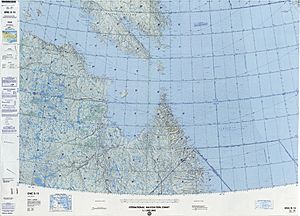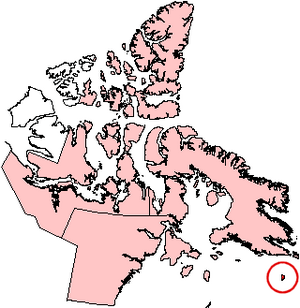Akpatok Island facts for kids

Akpatok Island and Ungava Bay.
|
|
| Geography | |
|---|---|
| Location | Northern Canada |
| Coordinates | 60°25′N 068°08′W / 60.417°N 68.133°W |
| Archipelago | Canadian Arctic Archipelago |
| Area | 903 km2 (349 sq mi) |
| Administration | |
|
Canada
|
|
| Territory | Nunavut |
| Region | Qikiqtaaluk |
| Demographics | |
| Population | Uninhabited |
Akpatok Island is a cool place in Canada's Nunavut territory. It's one of the many Canadian Arctic islands and nobody lives there! This island is the biggest one in Ungava Bay, which is off the northern coast of Quebec. Its name, Akpatok, comes from a bird called the Akpat, also known as the thick-billed murre. These birds love to live on the rocky cliffs around the island.
Contents
Island Geography: What Akpatok Looks Like
Akpatok Island is about 903 square kilometers in size. That's pretty big! The island is mostly made of limestone. It has tall, steep cliffs all around it. These cliffs rise between 150 and 250 meters above the sea.
Even though there are cliffs, you can still get to the top. Many deep ravines break up the cliffs, making it possible to climb up. At the top, there's a flat area. This flat part is about 23 kilometers wide and 45 kilometers long.
Amazing Animals: Who Lives on Akpatok?
Akpatok Island is a very important place for wildlife. It's known as an Important Bird Area in Canada. It's also a special spot for birds that migrate, meaning they travel long distances.
Many birds live here, especially the thick-billed murre. You can also find black guillemots and peregrine falcons. These falcons are known for being super fast!
Besides birds, bigger animals also visit the island and its waters. You might see polar bears, different kinds of seals, and even walruses.
Island History: A Look into the Past
People didn't always avoid Akpatok Island. At the southern end of the island, you can find signs of an old settlement. These are the remains of a Dorset settlement. The Dorset people were an ancient group who lived in the Arctic.
More recently, in July 1971, people drilled for oil on the island. They were trying to find oil there. Today, all that's left from that time are some old, broken shelters and rusty equipment.
See also
 In Spanish: Isla Akpatok para niños
In Spanish: Isla Akpatok para niños





